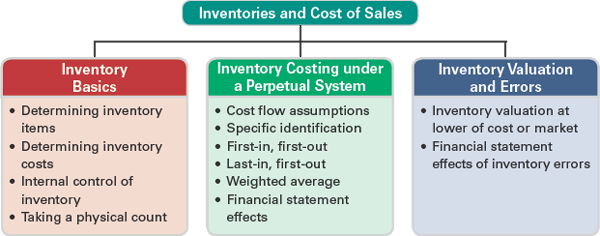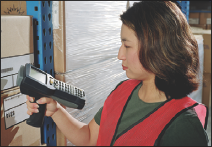
- •Inventory basics
- •Internal Controls and Taking a Physical Count
- •Inventory costing under a perpetual system
- •Inventory Cost Flow Assumptions
- •Inventory Costing Illustration
- •Valuing inventory at lcm and the effects of inventory errors
- •Inventory Turnover
- •Icon denotes assignments that involve decision making.
Chapter 6. Inventories and Cost of Sales
Chapter 5 focused on merchandising activities and how they are reported. We analyzed and recorded purchases and sales and explained accounting adjustments and closing for merchandisers.
![]() A
Look at This Chapter
A
Look at This Chapter
This chapter emphasizes accounting for inventory. We describe methods for assigning costs to inventory and we explain the items and costs making up merchandise inventory. We also discuss methods of estimating and measuring inventory.
![]() A
Look Ahead
A
Look Ahead
Chapter 7 emphasizes accounting information systems. We describe system principles, the system components, use of special journals and subsidiary ledgers, and technology-based systems.
Learning Objectives
CONCEPTUAL
C1 Identify the items making up merchandise inventory. (p. 230)
C2 Identify the costs of merchandise inventory. (p. 231)
ANALYTICAL
A1 Analyze the effects of inventory methods for both financial and tax reporting. (p. 238)
A2 Analyze the effects of inventory errors on current and future financial statements. (p. 240)
A3 Assess inventory management using both inventory turnover and days' sales in inventory. (p. 243)
PROCEDURAL
P1 Compute inventory in a perpetual system using the methods of specific identification, FIFO, LIFO, and weighted average. (p. 233)
P2 Compute the lower of cost or market amount of inventory. (p. 239)
P3 Appendix 6A—Compute inventory in a periodic system using the methods of specific identification, FIFO, LIFO, and weighted average. (p. 249)
P4 Appendix 6B—Apply both the retail inventory and gross profit methods to estimate inventory. (p. 254)
Page 229

“We had to be really creative.”
—FELECIA HATCHER
Decision Insight
 Cool
Company
Cool
Company
MIAMI—“America is, and will always be, a place of unlimited opportunity for all who dream,” insists Derick Pearson. Derick, along with his soon-to-be-wife Felecia Hatcher, launchedFeverish Ice Cream (FeverishIceCream.com) after losing their jobs. Their company sells gourmet ice pops and ice cream concocted in their production facility, and the two sell them using ecofriendly, acid green carts and a Scion. Felecia explains that they focus on venues that attract young adults such as music events, campuses, skate parks, and farmers' markets. Their travels are posted on Twitter and Facebook.
The company launch, however, was a challenge. “We purchased two tricycle carts that we found on Craigslist,” explains Felecia. “As the business grew, we were able to reinvest more money into it, buy more equipment.” The couple also had to confront inventory production and sales planning, and had to deal with discounts and allowances.
A major challenge was identifying the appropriate inventories while controlling costs. “In the beginning it was just a lot of trial and error,” says Felecia. “We had a lot of melted ice cream!” Applying inventory management, and old fashioned trial-and-error, Felecia and Derick learned to fill orders, collect money, and maintain the right level and mix of inventory. To help, they set up an inventory system to account for sales and purchases in real time.
The two insist that while it is important to serve customers' needs, business success demands sound inventory management. Further, that success requires more than good products and perpetual inventory management. Felecia explains that it requires commitment, patience, energy, faith, and maybe some luck. “It was a crazy idea but we really didn't have anything to lose,” recalls Felecia. “Loving ice cream fueled a lot of our madness!”
While Derick and Felecia continue to measure, monitor, and manage inventories and costs, their success and growth are pushing them into new products and opportunities. “[We are] always about growing as organically as possible,” asserts Felecia. “[Including] sustaining that growth.” Their inventory procedures and accounting systems contribute to their lean business model. “[We] budget every cent, along with saving for future expenses,” explains Derick. “There's nothing wrong with living simple,” says Felecia. “Spend money on things that will last, and make do with what you have.” Adds Derick, “We are living examples that dreams do come true!”
[Sources: Feverish Ice Cream Website, January 2013; South Florida Times, November 2011;Palm Beach Post, July 2011; Graves Publishing Company, February 2010; Miami New Times,November 2011]
Page 230
Chapter Preview
Merchandisers' activities include the purchasing and reselling of merchandise. We explained accounting for merchandisers in Chapter 5, including that for purchases and sales. In this chapter, we extend the study and analysis of inventory by explaining the methods used to assign costs to merchandise inventory and to cost of goods sold. Retailers, wholesalers, and other merchandising companies that purchase products for resale use the principles and methods described here. Understanding inventory accounting helps in the analysis and interpretation of financial statements and helps people run their businesses.

Inventory basics
This section identifies the items and costs making up merchandise inventory. It also describes the importance of internal controls in taking a physical count of inventory.
Determining Inventory Items
C1 Identify the items making up merchandise inventory.
Merchandise inventory includes all goods that a company owns and holds for sale. This rule holds regardless of where the goods are located when inventory is counted. Certain inventory items require special attention, including goods in transit, goods on consignment, and goods that are damaged or obsolete.
Point: FOB shipping point is also called FOB origin or FOB supplier's warehouse.
Goods in Transit Does a purchaser's inventory include goods in transit from a supplier? The answer is that if ownership has passed to the purchaser, the goods are included in the purchaser's inventory. We determine this by reviewing the shipping terms: FOB destination or FOB shipping point. If the purchaser is responsible for paying freight, ownership passes when goods are loaded on the transport vehicle. If the seller is responsible for paying freight, ownership passes when goods arrive at their destination.
Goods on Consignment Goods on consignment are goods shipped by the owner, called theconsignor, to another party, the consignee. A consignee sells goods for the owner. The consignor continues to own the consigned goods and reports them in its inventory. Upper Deck, for instance, pays sports celebrities such as Aaron Rodgers of the Green Bay Packers to sign memorabilia, which are offered to shopping networks on consignment. Upper Deck, the consignor, must report these items in its inventory until sold.
Goods Damaged or Obsolete Damaged and obsolete (and deteriorated) goods are not counted in inventory if they cannot be sold. If these goods can be sold at a reduced price, they are included in inventory at a conservative estimate of their net realizable value. Net realizable value is sales price minus the cost of making the sale. The period when damage or obsolescence (or deterioration) occurs is the period when the loss in value is reported.
Page 231
![]()
![]() Decision Insight
Decision Insight

A wireless portable device with a two-way radio allows clerks to quickly record inventory by scanning bar codes and to instantly send and receive inventory data. It gives managers access to up-to-date information on inventory and its location.
Determining Inventory Costs
C2 Identify the costs of merchandise inventory.
Merchandise inventory includes costs of expenditures necessary, directly or indirectly, to bring an item to a salable condition and location. This means that the cost of an inventory item includes its invoice cost minus any discount, and plus any incidental costs necessary to put it in a place and condition for sale. Incidental costs can include import tariffs, freight, storage, insurance, and costs incurred in an aging process (for example, aging wine or cheese).
Accounting principles prescribe that incidental costs be added to inventory. Also, the matching (expense recognition) principle states that inventory costs should be recorded against revenue in the period when inventory is sold. However, some companies use the materiality constraint (cost-to-benefit constraint) to avoid assigning some incidental costs of acquiring merchandise to inventory. Instead, they expense them to cost of goods sold when incurred. These companies argue either that those incidental costs are immaterial or that the effort in assigning them outweighs the benefit.
